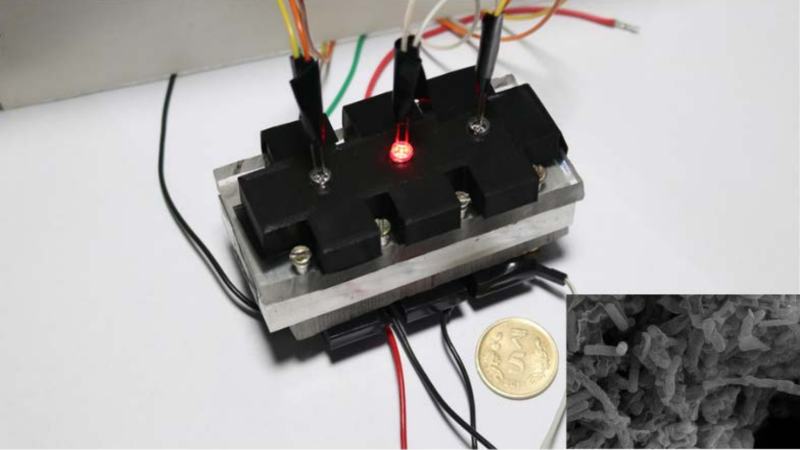
The assembled prototype MANAS; Inset-SEM image of bacteria grown inside the module (Image credits: Authors of the paper)
Humanity is poised to witness people returning to the moon and building habitats on it in the coming decade. Scientists envision building these habitats with local resources -- using lunar soil as the construction material. For this, they propose to exploit a property seen in some soil bacteria. These bacteria produce minerals as a byproduct of their digestion process, and the residue hardens in the soil glueing the particles together. However, how well these bacteria thrive in the harsh environs of space is still being researched. Further, conducting these microbiology experiments with bulky lab-scale equipment is not viable in space, so scientists are shrinking the labs to fit on chips. Developing space-suitable miniature ‘lab-on-a-chip’ modules is an active research area.
In one such attempt, researchers from the Indian Institute of Science (IISc), Bengaluru, collaborated with Drs Anuj Nandi and Arjun Dey from the U R Rao Satellite Centre, Indian Space Research Organisation (ISRO), Bengaluru, and developed a fully automated modular prototype device called MANAS (Microbial Analyses in Space) that provides a laboratory-like environment to conduct simple microbiology experiments in space. The team has performed preliminary ground-based experiments to demonstrate the efficacy of MANAS by evaluating the growth patterns of a soil bacteria called Sporosarcina pasteurii. The results of their experiments are published in the journal Acta Astronautica. The study was funded by the DBT-BioCare fellowship and partially by IISc-ISRO Space Technology Cell (STC).
Some soil bacteria metabolise organic compounds from their surroundings and convert them to inorganic precipitates such as calcium carbonate. These hard precipitates surround them, bridging the soil particles. Corals, seashells, enamel are a few natural examples of the biomineralisation phenomenon. Scientists propose to use this biocementing property -- called Microbially induced calcite precipitation -- of soil bacteria on lunar soil to harden it and construct habitats.
In their earlier studies, the IISc team identified Sporosarcina pasteurii as a promising candidate for experiments in space applications. The bacteria exhibits not only biocementing properties but also forms spores that remain dormant in harsh environs. These spores can be stored in powder form, and when nutrients are restored, the bacteria begin to grow.
“We experimented with the bacterial activity on lunar soil simulant (ISRO’s soil composite formula that is 99.6% similar to moon soil) and found that the bacteria hardens the soil by forming calcite (calcium carbonate) precipitates bridging the soil particles together. With further processing, we can turn these into space bricks,” says Dr Aloke Kumar, who pioneered the bacterial studies and is a co-author of the present study. But, first, the team had to ascertain if Sporosarcina pasteurii could thrive in space, and MANAS paved the way for the experimentation.
At the heart of MANAS are cassettes or the primary experiment zones. Each cassette is made of a transparent acrylic chamber filled with bacterial spores suspended in sucrose solution. Millimetre thick channels carry nutrients to the chamber. Electrically actuated solenoid valves open at designated periods to control the fluid flow. At the top of the chamber is an LED and at the opposite end is a sensor (photodiode).
The cassettes are placed in cartridges. The cartridge has a pre-programmed microcontroller that controls the logical flow of the experiment: such as pumping the nutrient to the chamber, monitoring the fluid flow, storing the recorded data in flash memory and, if necessary, transmitting real-time data to ground control.
The cartridge, in turn, is placed in a housing with a master controller that collates readings from all the cartridges and oversees the telemetry -- the live transmission of data to ground control. MANAS was tested at different temperatures, pressure, and orientations as required for space conditions. Presently, the team is working on the final modifications of the housing design to isolate the cartridge from the exterior environment.
“The device works on the simple concept of measuring the optical density of the fluid in the chamber. As bacteria begin to grow, the liquid turns turbid, thereby changing the density of the light (from the LED) passing through the chamber. The sensor at the other end picks up the variations as a function of time,” explains Dr Koushik Viswanathan, corresponding author of the paper.
The team used the device to record the growth rate and pattern of the bacteria for 40 hours at 10-minute measurement intervals. “We noticed an initial lag in the growth as the bacteria were getting acclimatised to the simulated conditions. But, after that, there was an exponential growth rate,” says Dr Kumar. The growth peaked for a few hours, after which, as the nutrients reduce, the bacteria begin to die, he adds. Later, they analysed the chamber contents under a scanning electron microscope. The team observed substantial growth of the rod-shaped bacteria in the individual cassettes. Some had formed spores.
“MANAS is a versatile lab-on-a-chip module that can be used for various other microbiology experiments. Simultaneous experiments can be run in each cartridge with each cassette holding several stages of the experiment,” says Dr Viswanathan.
Besides, multiple experiments can be conducted by altering the cassette contents or their numbers, he adds. The team now looks to test their device in space by developing a suitable flight model that can fit onto one of ISRO’s satellites.
This article has been run past the researchers, whose work is covered, to ensure accuracy.






